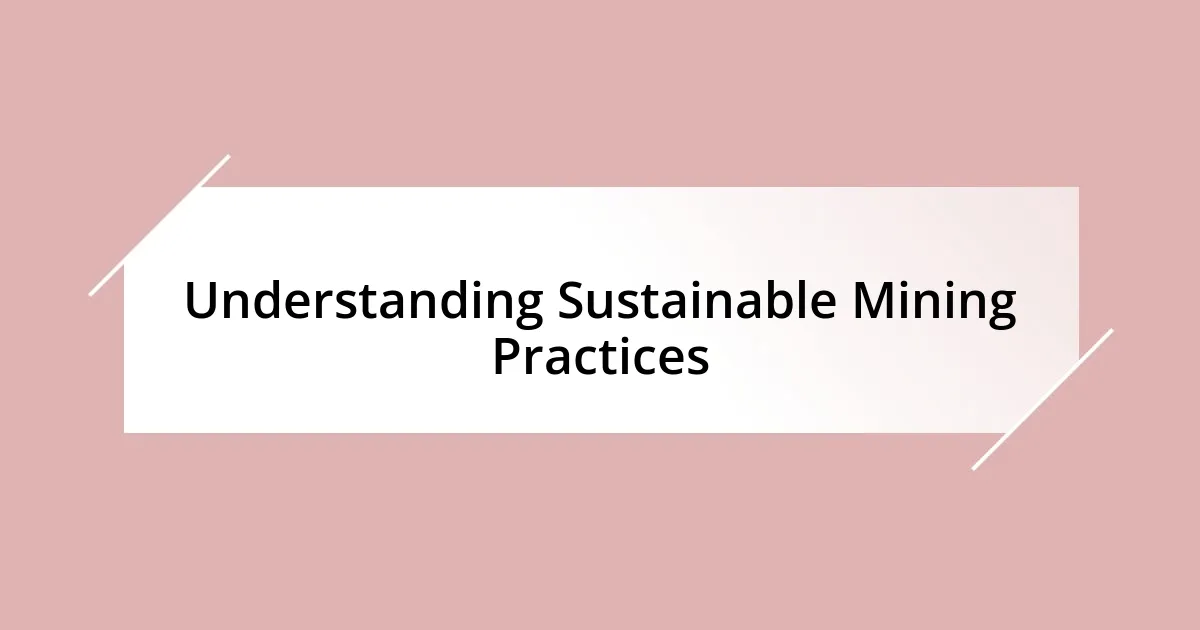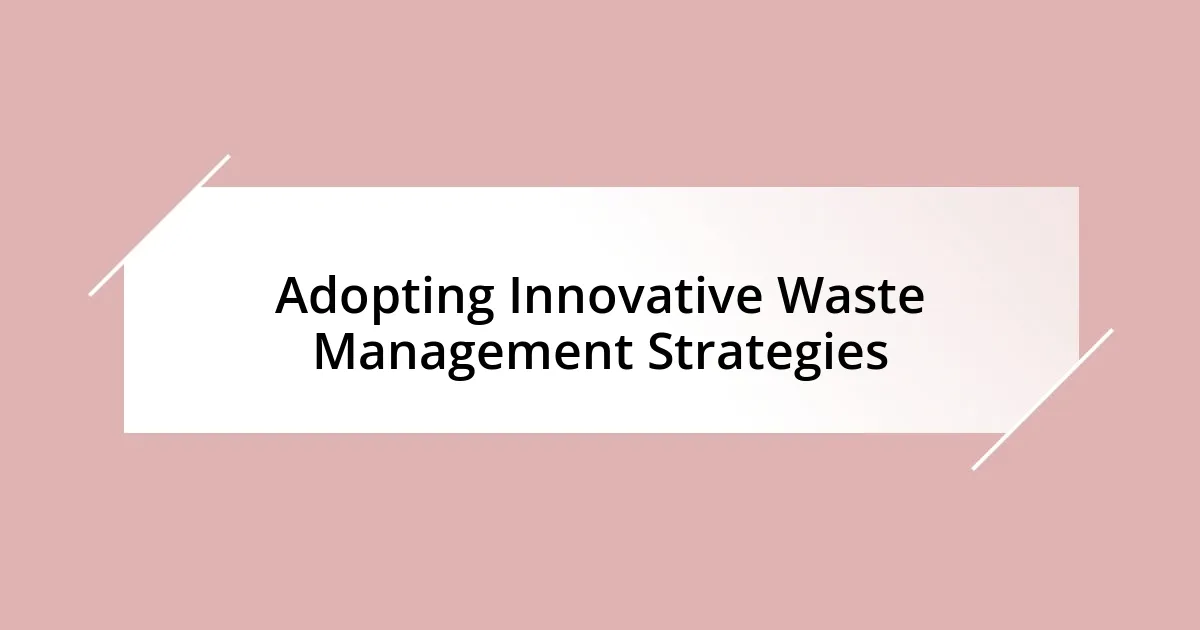Key takeaways:
- Sustainable mining practices focus on minimizing environmental impact and engaging local communities for lasting positive change.
- Integrating technology, such as water recycling systems and energy-efficient technologies, is crucial for enhancing operational sustainability.
- Utilizing comprehensive data analysis, stakeholder consultations, and multi-criteria decision analysis improves environmental impact assessments.
- Proactive community engagement and innovative waste management strategies can transform challenges into valuable resources and opportunities.

Understanding Sustainable Mining Practices
Sustainable mining practices aim to minimize environmental impact while ensuring economic viability. I remember visiting a mining site that implemented innovative techniques to reduce waste. Standing there, I could see how they used water recycling systems, and it made me realize just how crucial these practices are for protecting our planet.
One aspect that particularly resonates with me is the focus on community engagement. Mining doesn’t just happen in isolation; it affects local communities. Have you ever considered how decisions made by corporations can transform a town? I’ve spoken with residents who felt heard when companies invested in education and infrastructure, creating a lasting positive impact that goes beyond economic profits.
Furthermore, I’ve found that technological advancements play a key role in sustainable mining. For instance, I was intrigued by how drone technology allows for precise mapping, reducing the need for extensive land clearing. It made me wonder—what’s next for the industry? The possibilities are exciting, and it gives me hope that we can mine responsibly while safeguarding the environment for future generations.

Assessing Environmental Impact Effectively
One of the most important things I’ve learned in assessing environmental impact is the necessity of integrating comprehensive data analysis. When I collaborated with a team using software to model mining operations’ effects on local ecosystems, I was astounded by the insight it provided. This analytical approach not only identified potential harm but also highlighted areas for improvement, reinforcing the idea that informed decisions lead to more sustainable practices.
In my experience, stakeholder consultations often reveal hidden impacts that may not be apparent in initial assessments. I vividly recall a meeting with local fishermen who shared how sediment from mining activities affected their catches. Listening to their stories opened my eyes to the multifaceted relationship between mining and local economies. This intersection of direct experience and ecological research has taught me that assessing environmental impact is not just about the numbers, but also about listening to those who are affected.
Employing multi-criteria decision analysis (MCDA) can also enhance the effectiveness of environmental impact assessments. During a recent workshop, I observed how MCDA helped participants weigh various factors such as biodiversity, social implications, and economic outputs. It’s fascinating to see how these frameworks encourage holistic thinking in a way that linear assessments simply cannot.
| Assessment Method | Pros |
|---|---|
| Data Analysis | Provides insights into patterns and potential impacts |
| Stakeholder Consultations | Reveals local knowledge and perspectives |
| Multi-Criteria Decision Analysis | Encourages comprehensive, holistic decision-making |

Implementing Energy Efficient Technologies

Implementing Energy Efficient Technologies
In my experience, the heart of sustainable mining lies in adopting energy-efficient technologies. One time, I visited a site that installed solar panels on their operations. Watching the crew harness sunlight made me feel optimistic about the future. It wasn’t just about lower energy bills; it was about creating a cleaner workplace and supporting the community by reducing dependence on fossil fuels. That’s a win-win in my book!
I’ve also noticed that implementing these technologies comes with a range of benefits. Companies not only enhance their reputation but often find significant cost savings in the long run. These advancements are changing the mining landscape—slowly, yet surely. Here are some energy-efficient technologies worth considering:
- **Electric Haul Trucks**: These reduce emissions and operational costs while improving energy efficiency.
- **Advanced Process Control Systems**: They optimize equipment performance and reduce energy consumption during operations.
- **Renewable Energy Sources**: Integrating wind and solar power into operations can drastically cut down on reliance on traditional power grids.
- **Energy Recovery Systems**: These capture excess energy from various processes and reuse it, minimizing waste.

Promoting Responsible Water Use
One aspect of sustainable mining that truly resonates with me is the critical importance of responsible water use. I remember a project where we implemented water recycling systems that treated and reused wastewater. Witnessing the transformation from a once-polluted source to clean water for irrigation was profoundly moving; it felt like giving back to the earth. Don’t you think that this approach can redefine how we perceive water as a finite resource?
Every time I discuss water management strategies with colleagues, I emphasize the urgency of reducing freshwater consumption. During a recent field visit, I was struck by the stark contrast between two mining sites: one that was actively conserving water by using advanced techniques, and another that was depleting local aquifers. The local communities had concerns that were palpable—and it made me reflect: what legacy do we wish to leave behind?
Moreover, integrating technology can boost our water management efforts significantly. On one of my own projects, I encountered sensors that monitor water usage in real-time, allowing us to make timely adjustments. The efficiency gains were impressive, and it was a relief to know we were protecting essential water resources while enhancing operational effectiveness. Isn’t it inspiring to know that technology can be a powerful ally in responsible mining practices?

Engaging Local Communities Proactively
Engaging local communities proactively is vital for sustainable mining. I remember attending a community forum where we really listened to residents’ concerns about a new mining project. It struck me how crucial it is to keep communication lines open—when locals feel heard, they are more likely to support initiatives that impact their lives. Have you ever noticed how a simple conversation can change perceptions?
I once participated in a program where we involved local artisans in our site’s development planning. It amazed me to see how their creativity and knowledge enriched our projects. Not only did this foster trust, but it also created job opportunities and strengthened cultural ties within the community. Isn’t it heartwarming to think that collaborative efforts can transform not just landscapes but lives?
Furthermore, incorporating feedback from community members into our operations can lead to innovative solutions. For instance, during a project review, I facilitated discussions that allowed residents to voice their ideas for responsible resource management. The result was surprising—a fresh perspective emerged that we hadn’t considered before. This experience taught me that engaging locals is not just beneficial; it enriches our endeavors and bridges gaps between industries and communities. How could we harness this potential further in our future projects?

Adopting Innovative Waste Management Strategies
When it comes to waste management in mining, I’ve seen firsthand how innovative strategies can make a world of difference. For example, I was part of a project that implemented a closed-loop system to manage tailings—basically, the leftover materials after the mining process. Watching this system not only minimize waste but also recover valuable minerals made me realize just how much potential we leave untapped if we don’t think outside the box. Isn’t it fascinating how innovation can turn waste into a resource?
I recall one incident where we experimented with waste-to-energy technology, converting discarded materials into usable energy. The initial skepticism was palpable, but as we gathered data, the benefits became clear. Not only did this reduce our landfill waste, but it also powered parts of our operations. Seeing the team’s excitement as we realized we were not just managing waste, but actually creating something valuable, was incredibly rewarding. How often do we come across opportunities like this that challenge our traditional views?
Moreover, integrating artificial intelligence in waste management is something I’m now particularly passionate about. On one of my recent projects, we used AI to predict waste generation patterns, allowing us to optimize our processes preemptively. It was a revelation! Suddenly, the idea of waste wasn’t something we had to manage reactively—it became an element we could control. This proactive approach shifted my perspective: what if all industries embraced AI to drive sustainability in ways we haven’t even imagined yet? The possibilities are truly exciting!

Monitoring and Reporting Sustainability Progress
Monitoring and reporting sustainability progress in mining can sometimes feel overwhelming, but I’ve learned to embrace it as a journey rather than a checklist. On one project, I used a simple dashboard to track our key performance indicators regularly. Over time, I saw how the visual representation of our progress sparked more meaningful conversations within the team. Isn’t it amazing how a clear picture can turn abstract goals into shared achievements?
During an annual sustainability review, I felt a mix of anticipation and nervousness. I presented our findings, which included both successes and areas needing improvement. The openness of that meeting surprised me—it became a platform for candid discussions about our challenges. I realized that vulnerability in reporting isn’t a weakness; it fosters accountability and shows we’re committed to our goals. Shouldn’t we celebrate the learning moments just as much as the victories?
I’ve also come to appreciate the role of technology in enhancing our monitoring efforts. For instance, we adopted real-time data collection tools that offered insights into our environmental impact continuously. The excitement in the team was palpable when we could see the immediate effects of our initiatives. This connection made us feel like we weren’t just reporting numbers; we were narrating a story of progress that everyone could relate to. How often do we have the chance to see our actions translate into real-time change? It’s that instant feedback loop that truly motivates me.














